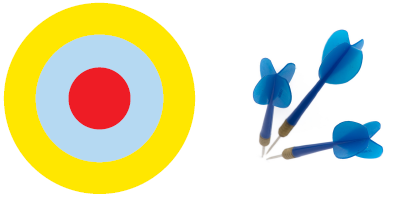This problem solving activity has a statistics focus.
Ngaio makes a dartboard with three concentric circles.
The smallest one has radius 1 metre; the next has radius 2 metres; and the third has radius 3 metres.
She paints the centre circle red; the first ring blue; and the outside ring yellow.
Ngaio is not a good darts player and her darts land at random on the board.
If she throws 100 darts, about how many would you expect to land in the yellow region?
What scoring system would you use for Ngaio if you wanted her, on average, to get the same score each time she threw 3 darts?
- Predict probabilities of an event involving area.
- Make deductions from probabilities.
- Devise and use problem solving strategies to explore situations mathematically (guess and check, be systematic, look for patterns, draw a diagram, make a table, think, use algebra).
This problem is about an appreciation of probability. A dice has six sides and every one is equally likely to land facing up. Hence the chances of any one particular face showing is one out of six or 1/6. For a dart randomly landing in an area, the probability of it landing in a given area is in proportion to the size of the area. In this problem students must find the relative areas of the board to determine the probabilities of the dart landing in a particular area.
- Copymaster of the problem (English)
- Copymaster of the problem (Māori)
- Paper and compasses
- Computer programme (optional)
The Problem
Ngaio makes a dartboard with three concentric circles. The smallest one has radius 1 metre; the next has radius 2 metres; and the third has radius 3 metres.
She paints the centre circle red; the first ring blue; and the outside ring yellow.
Ngaio is not a good darts player and her darts land at random on the board. If she throws 100 darts, about how many would you expect to land in the yellow region?
What scoring system would you use for Ngaio if you wanted her, on average, to get the same score each time she threw 3 darts?
Teaching Sequence
- Revise the idea of probabilities by talking about dice and coins. In particular, use them to discuss the probability of an event.
What is the probability of getting a 5 when you throw a dice? Why?
What is the probability of getting two heads in two throws of a dice? Why? - Pose Ngaio’s problem.
- Ask the class how they would find probabilities where are concerned.
What are the important things that you need to know?
How would you go about finding these things? - As the students work in groups, ask questions that focus on their understanding of probability.
Is any one spot on the board more likely than another?
Which region are you most likely to land in? Why?
How did you work that out?
Are you convinced that you are correct? Why/why not? - Allow students time to write up their conclusions
- Have groups share their solutions.
Extension
Construct Ngaio’s board and test the probabilities you have predicted above.
You might do this by computer and so run a longer simulation than you can by hand.
Solution
The problem says that the darts land at random on the board. So the proportion of the darts that land in the yellow region should be the same as the proportion of the total target that is yellow.
The area of the whole target (a circle with a radius of 3m) can be found using the formula for the area of a circle (πr2). π x 3m2 = 28.27m2
The area of the part of the target that is not yellow is a circle with a radius of 2m. π x 2m2 = 12.57m2
Therefore 12.57/28.27, or 44% of the board is not yellow. Therefore we would expect 44 of the 100 darts to land on that part of the board, and the rest, 56 of the darts, to land in the yellow region.
